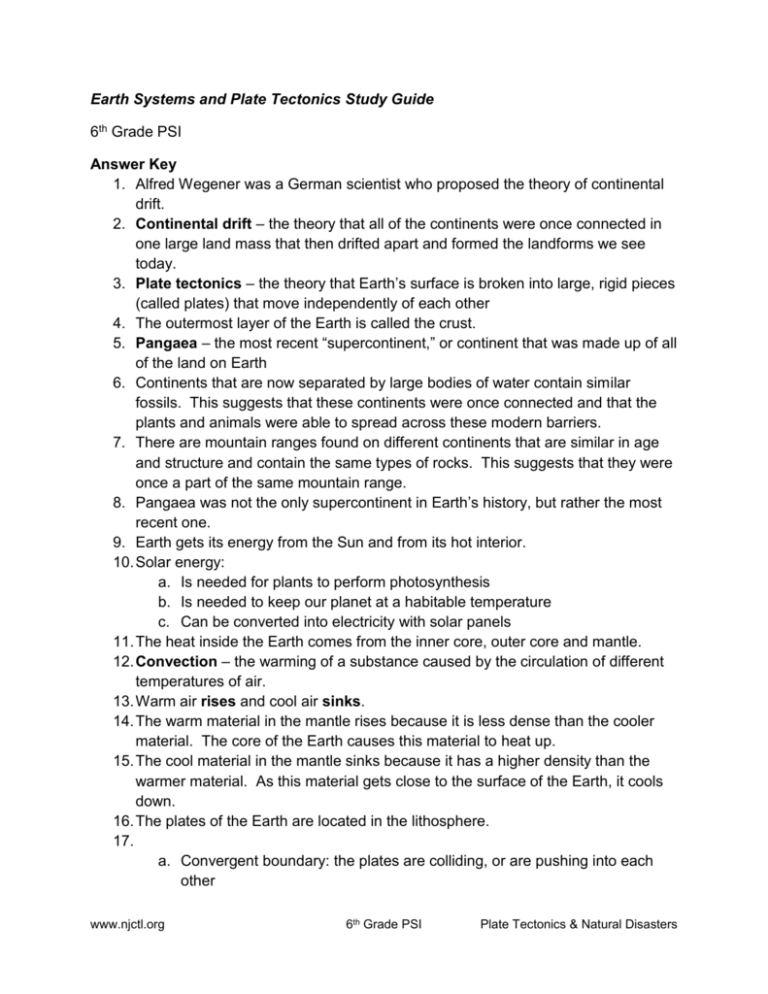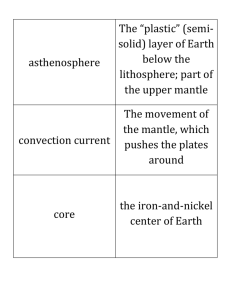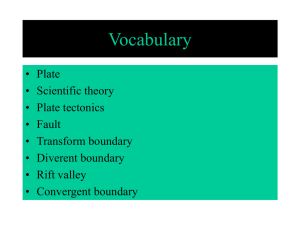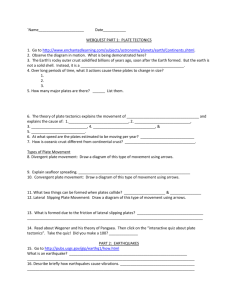Earth Systems and Plate Tectonics Study Guide 6th Grade PSI
advertisement

Earth Systems and Plate Tectonics Study Guide 6th Grade PSI Answer Key 1. Alfred Wegener was a German scientist who proposed the theory of continental drift. 2. Continental drift – the theory that all of the continents were once connected in one large land mass that then drifted apart and formed the landforms we see today. 3. Plate tectonics – the theory that Earth’s surface is broken into large, rigid pieces (called plates) that move independently of each other 4. The outermost layer of the Earth is called the crust. 5. Pangaea – the most recent “supercontinent,” or continent that was made up of all of the land on Earth 6. Continents that are now separated by large bodies of water contain similar fossils. This suggests that these continents were once connected and that the plants and animals were able to spread across these modern barriers. 7. There are mountain ranges found on different continents that are similar in age and structure and contain the same types of rocks. This suggests that they were once a part of the same mountain range. 8. Pangaea was not the only supercontinent in Earth’s history, but rather the most recent one. 9. Earth gets its energy from the Sun and from its hot interior. 10. Solar energy: a. Is needed for plants to perform photosynthesis b. Is needed to keep our planet at a habitable temperature c. Can be converted into electricity with solar panels 11. The heat inside the Earth comes from the inner core, outer core and mantle. 12. Convection – the warming of a substance caused by the circulation of different temperatures of air. 13. Warm air rises and cool air sinks. 14. The warm material in the mantle rises because it is less dense than the cooler material. The core of the Earth causes this material to heat up. 15. The cool material in the mantle sinks because it has a higher density than the warmer material. As this material gets close to the surface of the Earth, it cools down. 16. The plates of the Earth are located in the lithosphere. 17. a. Convergent boundary: the plates are colliding, or are pushing into each other www.njctl.org 6th Grade PSI Plate Tectonics & Natural Disasters b. Divergent boundary: the plates are dividing, or are moving away from each other c. Transform boundary: the plates are sliding past each other 18. Subduction – the process of one tectonic plate moving under another; this would occur at a convergent boundary 19. The boundary between the Indian and Asian plates is a convergent plate. You know this because the Himilayan mountain range is located on this boundary. 20. A mountain forms as two tectonic plates converge and collide into one another. As the two plates collide, they buckle, much like the hood of a car that has gotten in a head-on collision. 21. Seafloor spreading – the process by which new oceanic crust forms along a mid-ocean ridge and older oceanic crust moves away from the ridge; this can occur at a divergent boundary 22. Fault lines appear at transform boundaries. 23. Earthquakes – the result of a sudden release in energy in Earth’s crust that makes seismic waves. 24. Epicenter – the center point of an earthquake; the point where the earthquake is strongest 25. Earthquakes are measured using the Richter Scale. The Richter Scale measures from less than 2 (an earthquake that is barely noticeable) to 9+ (a catastrophic quake). 26. Earthquakes typically occur at transform boundaries. 27. The fault line that runs through California is called the San Andreas Fault. 28. An earthquake’s force depends on how much energy builds up between two tectonic plates that meet at a transform boundary. As plates slide past each other, they often get stuck. The longer they are stuck, the more powerful the earthquake will be when they finally move again. 29. There is no way to predict exactly when and where an earthquake will occur, but there are some areas that are more prone to getting earthquakes. Earthquakes cannot be predicted because we cannot see or feel the motion of Earth’s plates. 30. Tsunami – a series of water waves that occur as the result of a large volume of water being displaced because of an earthquake 31. Tsunamis will follow underwater earthquakes. 32. Areas that are prone to tsunamis can protect themselves by building sea walls that serve as barriers to hold back the water. 33. Volcano – an opening, or a vent, in Earth’s crust that allows hot magma, ash and gases to escape 34. Volcanoes can form at convergent and divergent plate boundaries. www.njctl.org 6th Grade PSI Plate Tectonics & Natural Disasters 35. a. Active volcano – volcano that is currently erupting or is likely to erupt; these are volcanoes that have erupted in the recent past b. Extinct volcano – volcano that is considered unlikely to erupt again; it has no more magma supply c. Dormant volcano – a volcano that still could erupt, but has not done so in a very long time 36. The Ring of Fire is the area that surrounds the Pacific Ocean. This area has 452 volcanoes and is home to over 75% of the active and dormant volcanoes on Earth. www.njctl.org 6th Grade PSI Plate Tectonics & Natural Disasters








